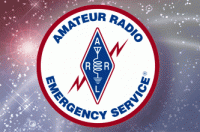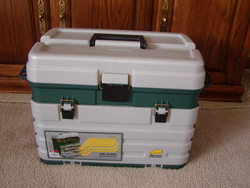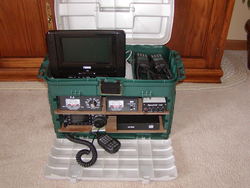|
Welcome,
Guest
|
TOPIC:
"Gone Fishing" : A Go-Box Option 10 years 8 months ago #271
|
With the increased interest in operating on a portable basis, hams can find it difficult to transport their equipment in a secure container that affords not only insulation and protection during transit, but also in dealing with the space limitations of RV's.
Tote boxes work, but are big and bulky. A friend of mine, Louis Stempek, AB8YO, suggested the use of a tackle box (figure 1). The largest tackle box on the market is the Plano 758; it affords the room needed. The first order of business was to remove the four tackle trays and fabricate new ones. I chose to use ¼ inch laminated mahogany but any ¼ inch wood will work. I installed two shelves that were spaced far enough apart to hold the equipment and easily slide in/out affording easy removal to change, add or repair equipment. In my version of the Go-Box, the radio is located on the bottom shelf in the mobile bracket next to the LDG auto tuner. On the upper shelf of my Go-Box is the MFJ-862 UHF/VHF wattmeter, an MFJ-860 HF wattmeter and on the far right is the SignaLink USB digital interface sound card for PSK, RTTY, and other digital modes. The meters are held in place with Velcro strips glued to the wood tray. The top of the tackle box doubles as storage where I keep a 60 watt dummy load, hand mic for SSB, keys, pens, and the 7 inch TFT display that plugs into the IC-7000. The power cable for the monitor, video cable from the 7000 and a USB cable from the SignaLink is fed via three holes drilled in the bottom of the storage tray and lead down to the 7000, SignaLink and a 12 volt Anderson power block. The USB cable is used to connect a laptop while in digital mode. Being plastic, the box was easy to cut and drill. The rear of my Go-Box features four connections; all are surface mount as I wanted to avoid snagging while in storage. Figure 3 shows the two surface mount SO-239's, one for HF and the other for VHF/UHF. The left side has two surface mount Anderson connectors, one for 12v and the other for ground (green). Both sides of the ground mount are soldered together inside so that no matter which side is used they go to ground. All ground connections inside the box -- rig, tuner, coax, etc. -- are tied to the Anderson ground terminal. Power is provided by an external Jetstream JTP34BCM switching 35 amp supply. I chose this particular supply for the ease of connection as it has PowerPole connectors front and rear. The 12 volt surface mount on the back of the Go-Box is connected to an Anderson six port power block attached to the upper shelf and sitting behind the watt meters where there is ample space. An internal power supply can be used; however, consideration must be given for running 120v AC into the Go-Box. I did not want AC inside the cabinet. The Jetstream provides more than enough DC to do the job. A smaller supply could be used but I already had the Jetstream and avoided purchasing another. Coax and power cabling needs to be kept as short as possible. There is not a lot of room behind the equipment and binding can take place when the trays are slid in. I had to cut a notch out of the bottom tray to allow for the microphone connection or use the connection on the rear of the 7000.The notch is visible beneath the VFO. The IC-7000 runs hot in the digital mode, even at 25 watts and additional cooling should be provided as the temperature gauge will climb into the red after prolonged use. I increased cooling by cutting a 2" diameter hole in the top shelf behind the VHF watt meter directly above the rig and installed a muffin fan facing down on the IC-7000 heat sink. This proved not to be enough cooling for long winded RTTY running at higher power, so another 2 inch muffin fan was installed in an upright position behind the LDG tuner facing the rig heat sink. In addition to the internal fan, there are now two external muffins cooling the rig. This did the trick and overheating is no longer an issue. The fans are plugged into the power block so they can be unplugged if not needed. Since they are muffin fans, noise is not an issue and can be left on. If digital modes are not going to be used then one fan is ample to do the job. There is no finite number of configurations available or rigs that can be used. If it fits it can be made to travel. My first version had an ICOM IC-2200H mounted in the mobile bracket in place of the SignaLink but I removed it as the IC-7000 has 2 meter capability. Two of my local friends use the ICOM IC-706mkIIg with great success using an internal power supply. What I have offered here is just food for thought and while this set up works for me it may not be what you want. I did not show pictures of the internal wiring as it is assumed the builder can figure out how to connect a piece of coax or plug in an Anderson Power Pole. Use your imagination, modify the tackle box to fit your needs and have fun where ever you go. -- Paul Zadonia, WD8CJN, Pinconning, Michigan [email protected] Source: www.arrl.org/FandES/field/ares-el/?issue=2013-05-15 |
|
Please Log in or Create an account to join the conversation.
Last edit: by WA1SFH.
|
Time to create page: 0.361 seconds


